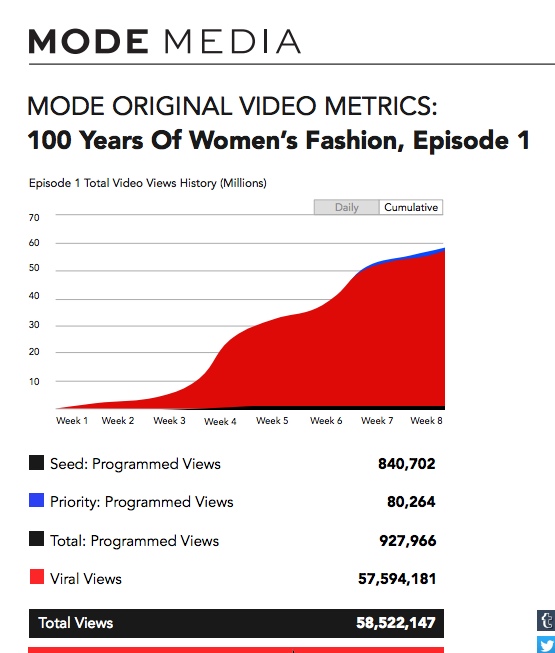Want smarter insights in your inbox? Sign up for our weekly newsletters to get only what matters to enterprise AI, data, and security leaders. Subscribe Now
Mode Media launched a video two months ago called “100 Years of Fashion in 2 Minutes” that has surpassed 50 million views, which the company says makes it the most-watched fashion video ever created.
The company said it achieved the feat with a “secret sauce” based on its own video technology, which it hopes to turn into a rival of Facebook and YouTube.
The fashion video is part of a multi-part series. The third one launches today. The second one, launched two weeks ago, has already gotten 20 million views.
The success comes just three months after Mode launched its own platform to focus on video streaming, which is delivering 140 million video streams a month, according to comScore. That makes it the 13th largest video site by reach. By way of comparison, Vimeo, a video site that launched more than a decade ago, gets 170 million streams a month.
Until Mode hit the record with its latest video, the most-watched fashion video was “L’Invitation au Voyage” with David Bowie by Louis Vuitton got 33 million views, according to Mode. (Here’s a link to that video on YouTube, although it doesn’t look official.)
In an interview with VentureBeat, Mode CEO Samir Arora explained what he said is the secret sauce of manufacturing viral videos:
First, the company creates the video and “seeds” it with select members of Mode’s 10,000 paid “curators.” It does this using data about which curators have responded most effectively to which content in the past. Each of the curators have their own point of view, users, social ranking, and reach.
Second, the company monitors how the video is spreading from those seeding efforts, and continues to seed with other curators based on their similarities to ones seeing the most effectiveness. So far, most of this activity is paid, and nothing is really viral yet. Arora calls these initial stages “growth hacking.”
The third step is where a video can possibly go viral. Once the seed stage gets the video in the right channels, organic views start spreading, and if the video hits the right note, it can get impressive uptake. It doesn’t always happen, but that’s what occurred with the 100 Years of Fashion video. As these viral views pick up, Mode can speed things up even more with a fourth step: using its new technology called “Priority Delivery.”
This last step guarantees that video is placed in the feeds of still more viewers based on their interests. The technology is similar to the one used by Facebook, where publishers can pay Facebook to “boost” videos higher in a user’s feed. Facebook uses an algorithm that determines which users are most likely to be interested.
The difference from Facebook, Arora said, is that Mode videos are created by professionals, not user-generated. This allows advertisers a greater comfort level for getting behind a video. In this sense, the experience is more like TV programming, he said.
As we reported three months ago when Mode launched the video offering, Mode is a unique animal. It’s hard to define without visiting it for yourself. Mostly it feels like a cross between Tumblr and YouTube, with social elements thrown in. But even that analogy isn’t quite right, because if you search for a home page for these viral videos, you’ll be disappointed. The videos are spread across the individual feeds of each user, which in turn are created by which curators the users follow. In that sense, it is more like Facebook or Twitter, where the video is posted millions of times and spreads. Mode is not a content “homepage” like Yahoo or BuzzFeed.
BuzzFeed, it should be noted, has created plenty of its own viral fashion videos. BuzzFeed relies on Facebook, however, and doesn’t control its own video network. Arora said the video platform sets Mode apart: “The payoff is that if you don’t control your own delivery platform, you are at the complete mercy of Facebook and Twitter.”
That said, you’ll still see a lot of Mode videos on other networks, including YouTube, because Mode’s strategy of seeding is open, and YouTube can still drive a lot of viral video. Mode aims to have about 70 percent of its traffic on Mode, versus 30 percent elsewhere, Arora said.


